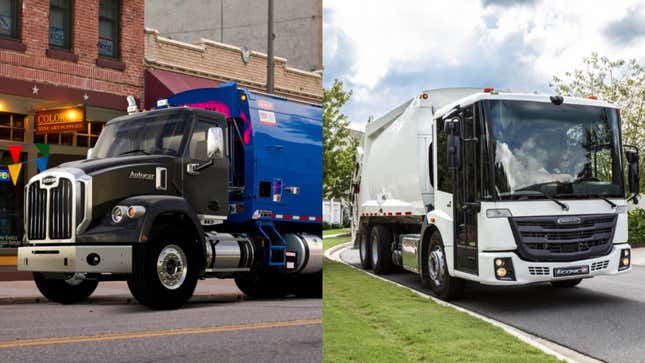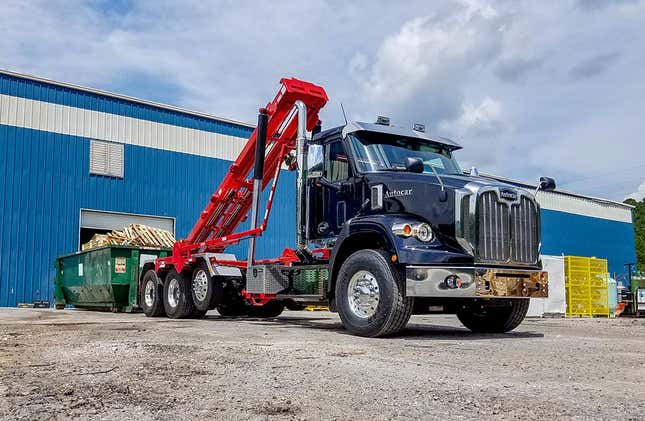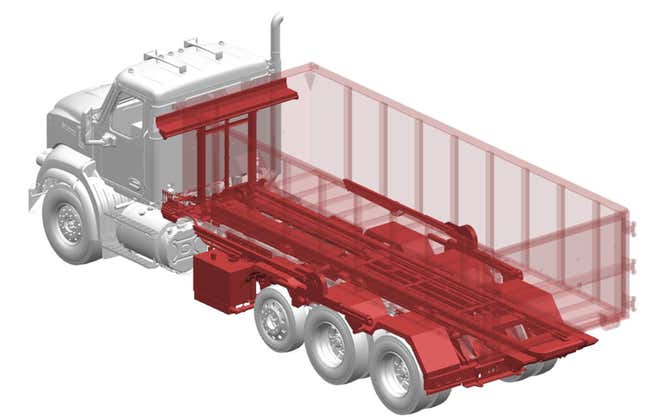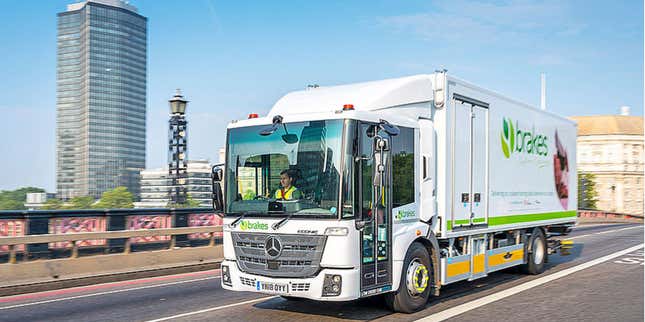
Unless you’re me at four years old, you probably don’t give garbage trucks much thought. Trash trucks are utilitarian machines by design. That much is clear. But behind the scenes, the sanitation management industry (not that one, the real one) is contending this year with the launch of two new ones from manufacturers Freightliner and Autocar. These trucks aren’t just new models. They represent completely different philosophies for how to design, build and market the rig that keeps our streets largely litter-free.
This past may, at the 2019 Waste Expo in Las Vegas, Autocar and Freightliner both introduced two new models aimed at the sanitation sector. Autocar, which lately has positioned itself as a niche player with a particular focus on waste management applications, brought its brand new DC-64R, a traditional conventional truck with a long hood. Freightliner, in contrast, actually brought someone else’s truck. Their EconicSD low entry cabover is actually largely a Mercedes Benz design that has been on the market for more than a decade. Daimler is introducing the truck to the American market through Freightliner, though, which it has owned since the early ‘80s.

Both manufacturers can claim deep roots. You’re probably familiar with Freightliner parent Daimler-Benz’s origin story, but Autocar also boasts a history that stretches back into the 19th century. Just eleven years after Karl Benz’s Motorwagen sputtered around southwest Germany, Autocar’s founder Louis Semple Clarke was building gasoline engines in Pittsburgh. Both companies took very different routes from that point forward, but, more than a century later, they both have experience building tough machines are up to dealing with the more than 260 million tons of refuse produced each year in the United States.
Autocar’s strategy to meet the needs of America’s sanitation engineers is to bank on brute strength. Its new rig is a conventional in all regards, not least of which its body style, which is the first bonneted truck to come out of Autocar’s plants in 31 years. Eschewing the lighter-weight largely aluminum cab of its Peterbilt and Kenworth competitors, the DC-64R has a bespoke cab built mostly from stainless steel and a chassis that Autocar says alleviates the need for frame liners and frees up more payload capacity.

Though Autocar is proud of the technical effort that went into their new truck, it has been most vocal about its“Power of One” manufacturing philosophy. This approach sees the processes of building a truck and up-fitting it for its business purpose integrated into one assembly system whereby issues of safety and regulation compliance are minimized. When the same crew builds the chassis and also fits the body, there’s less room for error. Autocar’s parent claims that their new approach will alleviate issues resulting from welding connections where they shouldn’t be, or drilling holes in the frame for electrical systems that can complicate repair and contribute to downtime.
These features come together in the DC-64R to represent a stark philosophical contrast to Freightliner’s new truck, which targets different issues faced by sanitation workers.
Freightliner doesn’t offer a body installation program similar to Autocar’s, and while they do note that the EconicSD was designed in consultation with body up-fitters, its killer features have to do more with working environment than the tasks at hand. Freightliner’s truck is a low-mounted cab-over-engine design that emphasizes efficient space utilization and maneuverability above all. Its axle far back behind the driver’s seat, the Econic is designed to perform at its best in urban environments, where corners are tight and drivers are constantly moving from the cab to the rear of the truck to make pick-ups. Freightliner is particularly proud of the EconicSD’s low entry, which can incorporate a bus-style two-piece door and kneeling suspension system, and only requires drivers to climb two steps into the driver’s seat.

More impressive, though, is the suite of safety features aimed at reducing accidents around the truck. Driver assistance tools for over-the-road trucks like Volvo’s active emergency braking system are old news at this point, but bringing similar technologies to city streets to reduce collisions has been a goal for many refuse fleets and Freightliner, via its parent Mercedes, has them covered. A suite of sensors designed by Detroit Assurance, another Daimler subsidiary helps with blind spot awareness and emergency braking, crucial factors in the tight quarters behind industrial buildings and in city alleyways where sanitation trucks tend to operate.
These city-oriented features are going to be a big help for urban garbage collectors, but they may also prove useful to other city truckers. The Mercedes version of the EconicSD (just called the Econic), which has been around a bit longer, has found other roles, like urban distribution, public works, and airport support. After launching in the garbage collection space, I wouldn’t be surprised if others catch on.

While both of these trucks represent current trends in garbage truck innovation, they are rather conventional when it comes to powertrain. Both trucks are offered with pretty standard powertrains, with a Cummins in the Autocar and a Detroit Diesel in the Freightliner. In Europe, the Mercedes Econic is available with a natural gas powerplant that is designed to significantly reduce emissions in urban environments, but it hasn’t made it to North America just yet. Freightliner itself also has begun to offer electric versions of some of its other models, so perhaps an electric EconicSD isn’t far down the line.
Both Autocar and Freightliner should think about electric power sooner rather than later, though. Chinese firm BYD, which has made strides in battery technology through partnerships with companies like Toyota, has already introduced an electric garbage truck to the American market, with testing underway in California. Established industry player Mack is also trying to electrify its long-running LR low-entry cabover as well so the field will be thick once Autocar and Freightliner eventually join the mix.

Until then though, Autocar and Freightliner are going to do their best to keep the garbage men and women of America equipped and ready to handle the worst of what we can through [out] at them.